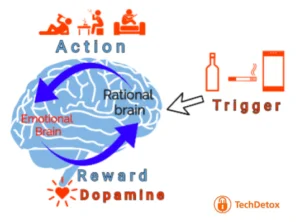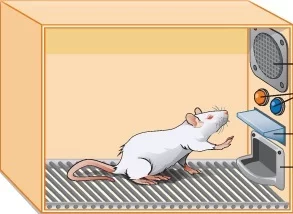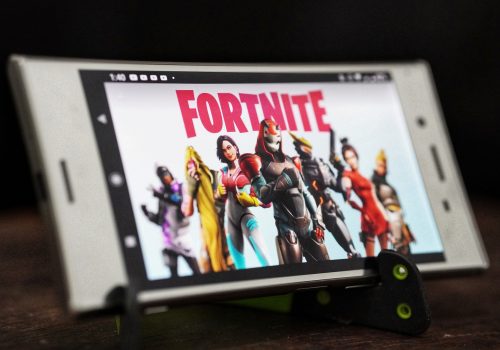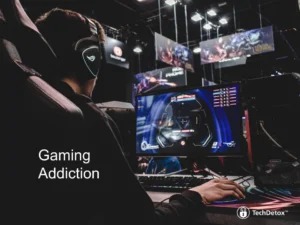The New Drug
The kid who first started playing Fortnite after school for fun is losing sleep, missing developmental milestones, destroying his academic performance and social relationships. The very ability to control his life is sacrificed to another kind of addiction – video games.
Playing Fortnite or taking drugs activates the same reward centers in the brain.
And like with any drug, with time the person needs larger and larger doses in order to get the same high. Computer games of today are faster, brighter, and louder than computer games from a decade ago. Geared for the ever-decreasing attention span, and ever-increasing desire for stimulation and excitement. For some young adults gaming addiction becomes such a big problem, that their families have to send them to a digital rehab center – a new and growing segment of rehab treatment.
NY Times magazine ran a story in 2019 featuring Charlie Bracke, whose life had been derailed by gaming addiction. The highlights included dropping out from college, losing a job, broken relationships, and severe depression. By Charlie’s estimates, he played video games 90 hours per week. At some point he realized that everything he ever wanted – home, family, job, income – he will never have. He slid into profound depression, and stopped taking care of himself completely. Gaming was the only thing that would alleviate the misery he felt. He knew he had a problem, but felt powerless to stop. In despair, he made plans to end his life. Fortunately, his parents interfered in time and were able to save his life by sending him to the video game addiction rehab center – remortgaging their home to pay for the treatment.
What is video game addiction?
The World Health Organization has included Gaming disorder in their official International Classification of Diseases (ICD-11) in 2018. It is described as “a pattern of persistent or recurrent gaming behavior, manifested by impaired control over gaming, increasing priority given to gaming to the extent that gaming takes precedence over other life interests and daily activities and continuation or escalation of gaming despite the occurrence of negative consequences.”
Internet Gaming Disorder (IGD) is described in the American Psychiatric Association‘s Diagnostic and Statistical Manual of Mental Disorders (DSM-5), which is used by mental health professionals to diagnose mental disorders. They have identified the following warning signs:
9 Symptoms of Video Game Addiction
- Preoccupation with gaming
- Withdrawal symptoms when gaming is taken away or not possible (sadness, anxiety, irritability)
- Tolerance, the need to spend more time gaming to satisfy the urge
- Inability to reduce playing, unsuccessful attempts to quit gaming
- Giving up other activities, loss of interest in previously enjoyed activities due to gaming
- Continuing to game despite problems
- Deceiving family members or others about the amount of time spent on gaming
- The use of gaming to relieve negative moods, such as guilt or hopelessness
- Risk, having jeopardized or lost a job or relationship due to gaming
It’s not an official medical condition yet, but it looks like it’s on its way there. And by the way, psychiatrists are quick to point out that this proposed condition does not include problems with other use of the internet, social media or smartphones. Internet Gaming Disorder and Internet Addiction Disorder are actually two separate conditions that are currently being debated for official inclusion into diagnostic manuals for mental health disorders. Internet addiction disorder is defined by the National Institutes of Health as any online-related, compulsive behavior which interferes with normal living.
I bet that a decade from now, psychiatrists would have an entire bouquet of digital media disorders to choose from. In short, digital media is officially on the list of addictions.
Gaming Industry Objects!
The gaming industry has disagreed with these classifications, calling them controversial and unfounded. A little bit of a conflict of interest there: in 2018 alone, the gaming industry generated almost $135 billion worldwide, it grows at double-digit rates every year, and is expected to reach $180.1 billion in revenue by 2021. The Entertainment Software Association representing the industry has deep pockets to lobby governments and fund research that will prove to the public that video games are good for you!
The more people get addicted to gaming, the more money they make.
Today, 2.5 billion people in the world are playing video games. Many of them are kids. According to the Pew Research Center, the majority of both boys and girls play video games, but gaming is nearly universal for boys – 97% say they play video games in some form or fashion. Estimates by the World Health Organization show that 3-4% of gamers are struggling with addiction challenges, with this figure expected to continue to grow as games become more engaging. Which means:
2.5 Billion People Gaming (AND GROWING) x 4% Addiction Rate (AND GROWING) =
100,000,000 Gaming Addicts (AND GROWING)
Nobody knows the exact numbers for sure, because most pathological gaming remains undiagnosed. In comparison, about 15 million people in the world use injection drugs, such as heroin. What is clear is that video game addiction has a potential to affect a lot more people than any drugs.
Mechanism of Addiction

The biological mechanism of addiction involves neurotransmitter dopamine, which is responsible for motivation, reward, and reinforcement of our behaviors. Addiction is now officially considered a disease of the reward center of the brain by American Medical Association and other healthcare authorities. Drugs, alcohol or certain behaviors stimulate dopamine production, the person experiences the rush of dopamine and the sensation of pleasure. The brain compensates by producing less dopamine and becoming less sensitive to it. After long enough exposure the brain suffers long-term damage and is no longer capable of producing the same levels of dopamine from normal human activities – a phenomenon called tolerance. Now the addict needs more and more of the substance or behavior to get the same high.
The brain has been hijacked.
To be happy, the person is now dependent on the substance or behavior they got addicted to, and the cravings are powerful. The neurochemical storm also disrupts communication between the emotional reward center and rational prefrontal cortex, further compromising self-control.
Gaming and gambling are similar behavioral addictions.
Before video games became an obvious problem, neuroscience has studied pathological gambling to prove that behavioral addictions involve the same brain mechanisms as drug addiction. Addicted gamblers destroy their livelihood and accumulate massive amounts of debt, because they experience diminishing feelings of satisfaction (and have to gamble more) and the pathways for impulse control in their prefrontal cortex have been disrupted.
It is a well known fact that the gambling industry does everything to facilitate this addiction – from the clever design of the casino floor, to free booze, to pumping oxygen into the room to keep people awake. Those magnificent casinos in Las Vegas have been built with the losers’ money. The house always wins. But they want players to believe that the winning jackpot is just one game away!
Enter the most obvious cue to wire in a gambling habit – the sound of the winning slot machine. This is a central idea of behavioral science – celebrate the wins, make people feel good to make them do more of what the casino wants. This exact idea was borrowed by the video game industry to hack the human brain. According to behavioral psychology, the one sure thing to create a habit is to celebrate the behavior! Give people what they want!
How Do People Get Hooked?
Is it all parents’ fault?! After all, who bought that gaming console as a Christmas gift?! No, do not blame the parents. Kids get addicted to video games because video games are intentionally designed to be addictive. Short of withdrawing from civilization and keeping kids away from all technology, there is little parents can do to prevent children from being exposed to video games sooner or later.
It’s not a moral failure of the parents.
It’s not a moral failure of the children.
It’s a moral failure of the industry that makes it’s products as addictive as cocaine.
Gaming companies pay millions to the best behavioral psychologists and neuroscientists, who advise them what features need to be integrated to make games as addictive as possible: those that trigger the release of high amounts of dopamine, forming a habit and even causing structural changes to the brain. After all, video game designers are running a multibillion dollar business to make a profit, hence the incentive to get more people playing video games, and get them to play longer. Behavioral scientists historically used lab rats in their experiments – now they are having a field day with tens of millions of human subjects worldwide!
In the 1950s, a well-known behavioral psychologist B.F. Skinner discovered you could control behavior through the use of a stimulus and a reward. He put lab rats in a box that isolated them from the external environment and had a behavior indicator such as a lever or a button. When the animal pushed the button or lever, the box would deliver a positive reinforcement of the behavior (food) along with noises and lights correlated with either the positive reinforcement or punishment. A box that isolates the subject from the world and delivers positive reinforcements for pressing buttons?
Isn’t that the very picture of video gaming?!

Another famous – and disturbing – experiment performed in the 1950s by psychologists James Olds and Peter Milner discovered the pleasure center of the brain by implanting electrodes into rats’ brains and connecting them with levers that rats could press. When electrodes were implanted near the pleasure center of the brain – nucleus accumbens – rats became so obsessed with pressing the levers up to 80 times a minute that they ignored food and water and pressed that lever until they died of exhaustion and dehydration .
There are real stories of gamers that actually died while playing video games. In Taiwan, Chen Rong-yu was playing an online game League of Legends at an Internet cafe for 23 hours straight, and died of a heart attack with his hands still on the keyboard and mouse. Another Taiwanese gamer, Hsieh, died of a heart attack after playing for three days straight.
Another cause of death by gaming is pulmonary embolism from sitting immobile for a long stretch of time. An 18-year-old named Chuang played Diablo 3 for 40 hours straight without taking any breaks for food or rest. He collapsed and was later pronounced dead in a hospital – possibly because of a blood clot after sitting in one place for almost two days. Chris Staniforth played on his Xbox for up to twelve hours at a time, and died from a blood clot blockage in his lungs. Rustam was a 17-year-old Russian teenager who broke his leg, started gaming and became addicted to Defence of the Ancients game, eventually playing for 22 days, non-stop, until he died from deep vein thrombosis.
A 26-year-old man from China named Zhang was addicted to World of Warcraft. He had gained over 320 pounds. After gaming for seven days straight, he was found slumping over his computer screen. He died from heart failure caused by his weight, poor blood circulation, and oxygen deprivation from sitting for too long.
How could people get so addicted that video games literally kill them?
Because our brain can be easily hacked.
Cognitive biases video game designers exploit
1. Celebrating the wins

According to the behavioral scientist BJ Fogg, who advised many Silicon Valley companies on the creation of digital products, when a habit is celebrated, it will stick. Video games celebrate player’s progress every few seconds with points, tokens, noises, dances, monsters spectacularly killed, visual effects, credits to acquire more stuff within the game, etc. It’s always party time, and you are a star! Everything that’s happening in the game is carefully engineered to make the player feel great. Because when the behavior feels great, it is repeated. Which is exactly what game creators need to make money. The reason is as old as time – just follow the money.
Early levels of a video game are intentionally designed to make it easy to feel successful. It makes the player feel good and keep playing. For example, Candy Crush is very easy to start with. It celebrates your every victory with satisfying dings and pop-ups. After you reach a certain score, the game says “Sweet!”. You are praised and celebrated. You feel great. You are successful!
But are you really, or have you been skillfully manipulated into feeling this way?
BJ Fogg has since written a book to help protect people from bad habits, including digital ones.
2. Sense of progress
So they hooked you. Now they need to reel you in.
Making the next level of the game just out of reach – challenging enough to motivate the player to keep gaming, but not too difficult to make him frustrated and stop trying. In this respect, video game addiction is very similar to gambling. You are that close to the jackpot!
Players in the game are given assignments to complete, and are rewarded with dopamine hits in the brain when they make progress in the virtual world – meanwhile, real world progress is standing still. Young people get hooked by gaming because the series of “small wins” built into computer games are intentionally designed to exploit the brain’s reward system by delivering a shot of dopamine to the pleasure centers of the brain, forming a habit.
Here is a disturbing ABC News report about the addictive nature of Fortnite, the most popular online multiplayer game. Parents in Quebec, Canada, actually filed a lawsuit against Epic Games Inc., the company behind the game, stating that it is as addictive as cocaine and ruins their children’s lives.
3. Instant gratification
Our brains are wired to conserve energy. That was useful to our ancestors on the savanna, not so much in a complex civilization of the modern world.
Your brain is looking for an easy and fun thing to do, not a hard and boring thing to do.
It’s called the path of least resistance, and it’s especially true for kids and teens whose prefrontal cortex – the area of the brain that is responsible for impulse control – is not developed yet. A video game is a world where you get instant gratification. Games are entertaining, easy to play for hours, and the brain craves the easy game, not the hard homework.
People have argued that computer games can be hard, and skills they develop – like hand-eye coordination – are transferable to the real world. To become good at the highly complex games of today kids need to invest a lot of time. It is estimated that it takes up to 50 hours to become an expert. But once those skills are built, they are rewarded – directly and frequently – to keep the player in the game. Hand-eye coordination may not get the player such positive feedback in the real world – people may not even notice! But instant gratification reliably happens in the game.
Building a mansion in Minecraft is still easier than building a patio in your backyard.
4. Stress relief and escape from problems
No need to think deeply and resolve issues. Run away from those pesky responsibilities. Games allow you to escape stressful reality and see yourself making progress in a virtual world instead. They create an environment where you feel safe and in control.
Even a rather innocent Candy Crush is engineered to get you to play whenever you have a free minute, because you crave those good feelings. You might be procrastinating or failing in real life, but here in the game you are a high achiever! Another level! What a relief! But if you pull yourself out of the instant gratification centers of your brain and engage your higher level rational thinking to ask yourself: “Is Candy Crush the habit I really want to have in my life?” Your emotional brain will give you a thousand justifications for enthusiastic “Yes!” because it wants you to keep playing – and relaxing.
Candy Crush is harmless stress relief, your emotional brain would say, you really NEED it because after all – your life is so stressful! What’s 5 minutes a day? Not a big deal!
Except in terms of biochemistry it’s the same kind of stress relief as a cocktail, or a cigarette, or marijuana joint, or a gambling spree, or a porn viewing session.
The same brain passages get engaged. The same dopamine gets released and wires the habit into the brain as “stress relief”. Very effective in the short term – but can be deadly in the long term. As with all addictive substances and behaviors, a tolerance is developed over time, requiring higher doses of drug or activity to achieve the same high.
Before you know it, you are playing Candy Crush 2 hours a day and are more stressed than ever because now you really don’t have the time to get important things done!
5. Perceived value
Manipulative game design features such as in-app purchases sell virtual stuff for real money to give players what they crave – progress in the game. If the player buys the virtual armor, weapons, extra lives, keys, whatever – they instantly look great, perform great, and win over other non-paying players. Like gambling,
“Pay to win” gaming can lead to financial ruin. Free cheese can only be found in a mouse trap. Predatory gambling tactics of in-app purchases are often aimed at young users: creators of Fortnite have been accused of this, but really any game with in-app purchases can be a slippery slope.
A game feature known as a loot box, with players either buying the boxes directly or receiving the boxes during play and later buying “keys” with which to redeem them, have even been declared illegal by many countries as a form of gambling. In September 2018, members from the gambling commissions from fifteen European nations as well as the state of Washington from the United States, announced a collaborative effort to “address the risks created by the blurring of lines between gaming and gambling”.
If you are a kid with no money of your own, you may not have an option to pay to unlock the game features you want, but you can unlock them one by one by simply playing the game for a long time. This is how the Battle Pass system within Fortnite works. The game gives kids quests and objectives to complete, and then rewards them with extra skins and emotes (dances/gestures).
Rewards for pressing buttons – remember the rats?
The stuff players accumulate in the game is perceived as real worth. It’s a display of their progress and achievement. It’s the cool looks of their game avatars. Gamers are attached to and protective of their loot. Virtual property is real for them, acquiring more of it taps directly into our human greed, losing it is devastating. “It’s my stuff!” The opportunities for manipulation by game designers are endless here.
6. Identity and belonging

The narrative of the game is monitored by sophisticated artificial intelligence (AI) algorithms that are designed to nudge the player in the direction of the story, mission or quest. An alternative reality way more stimulating than boring real life. A long-term immersive commitment that pretty much becomes part of gamer’s identity and makes them forget about the real world. AI is programmed to continue the story and keep the player engaged – sometimes indefinitely. The interaction between a preordained narrative of the game and player’s free will create a destiny.
AI is the God of the game. It’s job is to keep the players from leaving.
For addicted gamers, their avatar identity within the game supersedes anything they do in the real world. Their role and success within the game becomes their status, their basis of comparison to others, their sense of self-worth. That’s scary. With all the effort to succeed consumed by the virtual world, nothing is left for the real world. Life is short.
Addicted gamers choose to spend most of it within the game and abandon their humanity altogether.
The social aspect of the games is addictive, especially to kids and teens who lack social connection in real life. Kids often complete game quests and assignments in groups – sometimes “friends” they never met. Within the artificial social circles of video games there is no face-to-face contact, no non-verbal feedback for bad behavior, no accountability unless it’s about the game itself. There is an equally artificial sense of connection and belonging that would be harder to accomplish in real life. With more time spent in gaming chats, kids’ real-world communication skills atrophy. They are simply not equipped for a future job interview or building a healthy family.
7. Freedom of expression
In the highly immersive computer games of today there are no limits. The adventures and experiences are extraordinary. You can shoot strangers, jump from tall buildings, destroy property, be as rude and reckless as you want.
The freedom to operate in the virtual world without the rules and boundaries of the real world is intoxicating for kids.
Meanwhile, the real world seems more and more boring to the gamer’s overstimulated brain. To the concerned parents kids roll their eyes and tell that they know the difference and would never behave like that in real life.
But what if the brain does not know what’s real?
8. Complete withdrawal from reality

Enter Virtual Reality. It’s rapidly improving and is so realistic that it tricks the brain to believe. VR researchers at Stanford designed a demonstration. It starts in a simple room. When the subject puts on a VR headset, they find themselves in the same room, but the floor drops down and they are standing on a plank over a pit. Subjects experience all the classic markers of anxiety – heart racing, palms sweating – and their brain refuses to let them step off the plank. If the subjects force themselves to take a step, a pair of assistants always stands nearby to catch them – the brain is convinced they are falling.
As addictive and damaging as existing games are, the worst is yet to come. Virtual reality is expected to have greater addictive potential than their predecessors. An immersive multisensory environment that tricks our prehistoric human brain to believe it’s absolutely real plunges us straight into the science fiction worlds of movies like The Matrix or Avatar. Would people even want to engage with reality then?
Humans in The Martix are plugged into the machines and spend their whole lives in a virtual reality that is fed directly into their brains, blissfully unaware that they are slaves to the machines, and have no real life at all. In Avatar, a human character with the help of technology gets to operate a body of an alien in a bright magical world on another planet, and gets so wrapped up in his adventures, that his actual human body is dangerously neglected – because it is in a trance, hooked up to the computer in the trailer somewhere, abandoned by his owner without food or water, and in danger of being killed.
Massively Multiplayer Online Role Playing Games (MMORPG’s) which involve infinite possibilities and complexity, are considered the most addictive. Once these move to VR format, they can be equipped with the sensors that engage the whole body. The virtual world will be completely realistic, all the senses will be engaged, and the brain will not know the difference.
Our brains are essentially the same as they were 50 thousand years ago – they have always relied on inputs from the senses. Where is the guarantee that when the player (especially a child with the brain still forming) emerges back into the real world, the brain will have enough discernment to not shoot or steal or curse or use your real body in unnatural ways?
If the brain was trained to shoot with immunity in a virtual world that felt completely realistic, what guidance can such a brain give a person in the real world?
Real-Life Consequences of Video Game Addiction
Video game addiction wrecks havoc in every area of life:
Academic failure
When gaming addicts face the choice of whether to go to class or to keep gaming, they see education as a distraction, and refuse to go to school. Their grades plummet. They drop out of college and never complete their education.
Professional failure
Gaming addicts struggle with responsibilities of work. If a person spends over 10 hours a day gaming, usually well into the night, chances are they may not show up for work in the morning. They get fired. They cannot hold the job and struggle to find another, or don’t bother looking at all. Disappointed parents are stuck with a “failure to launch” grown adult living in their basement doing nothing but playing video games.
Relational failure
Without adequate face-to-face communication skills, gamers don’t know how to build relationships. Their reclusive lifestyles in front of a screen are poor training for dealing with real people. They cannot sacrifice their gaming priorities to accommodate the needs of another human being. If they do manage to start a family, they neglect their loved ones – too busy gaming. Frustrated spouses give up and file for divorce. Forgotten children grow up without a parent.
Physical failure
Immersed in their experience, gamers also neglect their health. They have poor diets consisting of junk food and energy drinks full of caffeine and sugar. They are malnourished and dehydrated. They suffer from sleep deprivation, gaming well into the night. With their sedentary lifestyle, they do not move their bodies enough and develop multiple problems: obesity, high blood pressure, diabetes, circulation issues and others.
Mental failure
Gaming addicts can be moody and physically aggressive. They have little patience, short attention span, and even shorter fuse. They experience a lot of stress and guilt – their real life is usually a total failure. Anxiety and depression are common, and withdrawal from social life makes it even worse – isolation is detrimental when it comes to mental health.
Death
Addicted video gamers already shorten their lives by poor diet, lack of exercise and sleep, and social isolation. With their health compromised, they are at risk of dying from heart failure, pulmonary embolism, dehydration, or suicide induced by depression and self-loathing.
Who is at Risk?
- Everybody. Video games are designed to be addictive – from the first try. Young men are the most susceptible, especially if they are lonely in their personal life, and/or not successful in their career.
- Young people. Undeveloped brains that are still “under construction” are especially vulnerable to “hard-wire” an addiction to substances or behaviors. The younger the person gets addicted, the harder it is to break an addiction later in life.
- People with neurological diagnoses. According to the reStart gaming addiction rehab center, many of their clients seeking video game addiction treatment have diagnoses of depression, anxiety, ADD/ADHD, and Autism spectrum disorder.
Solutions to Prevent Video Game Addiction
Awareness. Like with any addiction – understand that video games are dangerous. Awareness is the first step to prevention or healing. The majority of people playing video games have no problem balancing gaming and real life, but all need to be warned – be careful, and do not let gaming cross over into the addiction territory. Every game is full of addictive features, and more are being added all the time – people need to know this.
Boundaries. Parents have to limit the time kids spend gaming to under 2 hours a day. They also need to monitor the content of the games, weeding out those that are too violent or addictive. Games like Fortnite or World of Warcraft are also free and ubiquitous, available on a variety of platforms: Xbox, Playstation, Nintendo Switch, PC, Mac, iOS and Android. Parents need to restrict access across all of those, if necessary, physically removing the gaming devices.
Education. Check Common Sense Media and other reliable sources for game reviews and warnings (see Research and Resources sections on our website). Warning: gaming industry association is not one of them. They tend to put out statements like “The majority of parents view video games as beneficial for their children educational development”. They would like parents to believe it – for them, $180 billion is at stake.
Fill the void: screen-free alternatives. Sports, extracurricular activities, chores, free play, books, family dinners, travel, museums, board games, theatres, bike rides, hikes, restaurants, amusement parks, beaches, farms, gym, any real world human activity – organize it! If people call this overscheduling, so be it! Having a schedule filled with wholesome activities is better than leaving a vacuum that is so tempting to fill with video games.
Connection. Real world social connection with others have been the cornerstone of many addiction recovery programs, and video game addiction is no exception.
Rehab centers. That’s the last resort, where residential stay in a screen-free environment under the care of mental health professionals helps teens and young adults overcome gaming addiction.
National Policies. Some countries have implemented legal limits on screen time use to protect their citizens. In Taiwan, excess screen time is considered to be the equivalent of vices like smoking, drinking, and using drugs. Parents can be fined if their child’s use of electronic devices exceeds a reasonable time – which is determined if staring at screens for too long caused them to become physically or mentally ill. Similar laws exist in other Asian countries: China, Thailand, Vietnam. South Korea has a “Cool Down” law that shuts down a system after 2 hours of gaming, and was also famous for the so-called “Cinderella Law” that prevented youth from playing video games between midnight and 6am. After a lot of push back, the law has been reversed to – check this out – boost the gaming industry in South Korea. The government decided it’s up to the parents to decide how much time is safe for their kids to play video games.
Except in one rather oppressive country. In August, 2021, China banned users under 18 from playing online videogames during the school week. The only time kids are allowed to game is 8-9pm on Fridays, Saturdays, Sundays, and holidays. Why are they doing it? According to the Chinese authorities, to protect the future of their country. Instead of becoming addicted gamers, Chinese teenagers will rule the world when they grow up.
As for the American Academy of Pediatrics, they have decided to be hands off from the hot topic of screen time management: they do not have a specific screen time limit for children older than 6, leaving it to the parents to decide.
So the government would not help us. And medical authorities would not help us.
It looks like parents stand alone.
Take Back Control
Sign up for our monthly newsletter to receive latest digital wellbeing research and screen time management solutions. We never share your email with third parties.Footnotes and sources:
https://www.commonsensemedia.org/
https://www.netaddictionrecovery.com/
https://www.who.int/news-room/detail/24-04-2019-to-grow-up-healthy-children-need-to-sit-less-and-play-more
https://www.thegamer.com/15-people-who-have-died-playing-video-games/
https://www.pewresearch.org/internet/2018/05/31/teens-social-media-technology-2018/
https://www.nytimes.com/2019/10/22/magazine/can-you-really-be-addicted-to-video-games.html
https://www.statista.com/statistics/189582/age-of-us-video-game-players-since-2010/
https://www.theesa.com/
https://www.psychiatry.org/patients-families/internet-gaming
BJ Fogg, Tiny Habits
www.gamequitters.com
https://en.wikipedia.org/wiki/Loot_box
https://www.sciencedirect.com/science/article/abs/pii/S0165178117310375?via%3Dihub
https://en.wikipedia.org/wiki/Screen_time




as a kid, consider this: i play A LOT of normal Minecraft, and playing minecraft taught me that you can make glass out of sand. there is also minecraft education edition, where gamers can learn coding. my dad can relate (kinda), he played super mario when he was a kid, and when being on the pc a lot, i got smarter, i learnt how to download mods, i know how to use a VPN. and i watch youtube, and i think i learnt more useful thing from youtube than school could teach me in a year. i learnt history from Countryballs, Space and astronomy from NASA and Planetballs, so, RESPECT US KIDS AND WE DEMAND FREEDOM FOR ALL OF US, jokes aside,the internet helped me contact my irl friends, so i think you should let us play games and still keep parental controls, but not max security.
Great points about not all screen time being bad, and it’s fantastic that you you voluntarily choose educational content over mindless and addictive one. Respecting kids’ freedom within appropriate boundaries of digital safety is one of the objectives of parental controls. My kids play Minecraft and watch YouTube during their mutually agreed upon screen time hours, and I don’t bug them. But you should keep in mind that Big Tech does not care about your wellbeing. It is profitable for them to have addicted users gaming 18 hours a day, not functional adults living a successful life in the real world. A young brain is especially vulnerable to addictive design. Tech companies will not protect you. Government will not protect you. Parents will.